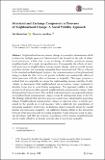Files in this item
Structural and exchange components in processes of neighbourhood change : a social mobility approach
Item metadata
| dc.contributor.author | Modai-Snir, Tal | |
| dc.contributor.author | van Ham, Maarten | |
| dc.date.accessioned | 2018-01-19T13:30:07Z | |
| dc.date.available | 2018-01-19T13:30:07Z | |
| dc.date.issued | 2018-01-19 | |
| dc.identifier | 251797727 | |
| dc.identifier | 49e2a24b-e8d3-4912-b84c-629bf193615b | |
| dc.identifier | 85040797423 | |
| dc.identifier | 000468999100011 | |
| dc.identifier.citation | Modai-Snir , T & van Ham , M 2018 , ' Structural and exchange components in processes of neighbourhood change : a social mobility approach ' , Applied Spatial Analysis and Policy , vol. First Online . https://doi.org/10.1007/s12061-017-9249-z | en |
| dc.identifier.issn | 1874-463X | |
| dc.identifier.other | ORCID: /0000-0002-2106-0702/work/64697537 | |
| dc.identifier.uri | https://hdl.handle.net/10023/12526 | |
| dc.description | The research leading to these results has received funding from the European Union’s Horizon 2020 research and innovation programme under the Marie Skłodowska-Curie grant agreement No. 702649; and from the European Research Council under the European Union’s Seventh Framework Programme (FP/20 07 - 2013)/ERC [Grant agreement No. 615159] (ERC Consolidator Grant DEPRIVEDHOODS, Socio-spatial inequality, deprived neighbourhoods, and neighbourhood effects). | en |
| dc.description.abstract | Neighbourhood socioeconomic change is a complex phenomenon which is driven by multiple processes. Most research has focused on the role of urban-level processes, which lead to an exchange of relative positions among neighbourhoods of a single metropolitan area. Consequently, the effects of structural processes on neighbourhood socioeconomic change, such as overall income growth or decline, and increasing inequality, have been neglected. This is reflected in the standard methodological practices; the common measures of neighbourhood change exclude the effect of overall growth or decline and confound the effects of urban processes with the effect of increase in inequality. This paper proposes a method that was originally developed for understanding income mobility of individuals, to decompose total neighbourhood socioeconomic change measured in absolute terms into its contributing components. The approach enables to take account of all processes that generate neighbourhood socioeconomic change, while distinguishing between them. The method is demonstrated in an empirical analysis of neighbourhood socioeconomic change across 22 metropolitan areas in the US. The findings indicate that structural processes can be most substantial in generating change. Neighbourhood socioeconomic change in ‘superstar cities’ is mostly generated by the growth in overall incomes, with a relatively low contribution of increasing inequality. Conversely, in declining cities it is mostly driven by overall decline and increasing inequality. An additional finding relates to the interaction between urban processes and increasing inequality. These processes work in opposite directions such that any increase in positions of low-income neighbourhoods can be totally offset by an income decrease due to increasing inequality. | |
| dc.format.extent | 21 | |
| dc.format.extent | 994325 | |
| dc.language.iso | eng | |
| dc.relation.ispartof | Applied Spatial Analysis and Policy | en |
| dc.subject | Urban change | en |
| dc.subject | Neighbourhood change | en |
| dc.subject | Structural processes | en |
| dc.subject | Relative change | en |
| dc.subject | Absolute change | en |
| dc.subject | Inequality | en |
| dc.subject | GF Human ecology. Anthropogeography | en |
| dc.subject | HT Communities. Classes. Races | en |
| dc.subject | 3rd-DAS | en |
| dc.subject.lcc | GF | en |
| dc.subject.lcc | HT | en |
| dc.title | Structural and exchange components in processes of neighbourhood change : a social mobility approach | en |
| dc.type | Journal article | en |
| dc.contributor.sponsor | European Research Council | en |
| dc.contributor.institution | University of St Andrews. School of Geography & Sustainable Development | en |
| dc.identifier.doi | https://doi.org/10.1007/s12061-017-9249-z | |
| dc.description.status | Peer reviewed | en |
| dc.identifier.grantnumber | ERC-2013-CoG | en |
This item appears in the following Collection(s)
Items in the St Andrews Research Repository are protected by copyright, with all rights reserved, unless otherwise indicated.

